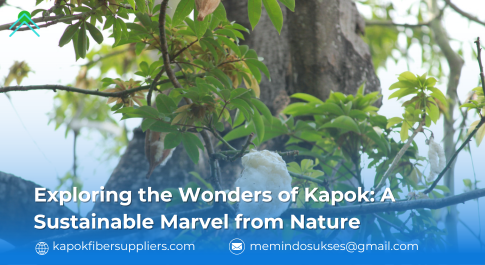
Exploring the Wonders of Kapok: A Sustainable Marvel from Nature
Kapok, often overshadowed by other natural fibers, is a remarkable and eco-friendly resource that has been used for centuries across various cultures. Known for its lightness, softness, and unique properties, kapok is derived from the fluffy seeds of the kapok tree (Ceiba pentandra), which is primarily found in tropical regions of Asia, Africa, and Central America. But kapok’s value extends far beyond its aesthetic appeal and traditional uses. Let’s dive deeper into the sustainable marvel that is kapok.
The Origins and History of Kapok
Kapok comes from the seed pods of the kapok tree, which can reach towering heights of up to 70 meters. The tree itself is an integral part of tropical ecosystems, often growing in rainforests where its massive roots anchor it firmly to the earth. The kapok pods, after being harvested, reveal the fluffy, cotton-like fiber that has long been prized for its softness and buoyancy.
Historically, kapok has been used in a variety of applications. Indigenous peoples in the tropics have utilized kapok for making bedding, mattresses, and pillows, capitalizing on its ability to provide a light yet supportive cushioning. Additionally, it has been used as an insulation material and as stuffing for life jackets due to its buoyant nature. In the past, it was even used as a substitute for down feathers in high-quality bedding.
Kapok’s Environmental Benefits
One of the most compelling reasons to consider kapok in modern times is its sustainability. Unlike synthetic fibers, which often require petrochemicals and intensive processing, kapok is 100% natural and biodegradable. Here are some of the key environmental benefits of kapok:
- Renewable Resource: Kapok is a renewable resource that doesn’t require the extensive land use or agricultural chemicals that other fibers like cotton demand. The kapok tree is naturally resilient, thriving in its native habitat without the need for fertilizers or pesticides.
- Carbon Sequestration: The kapok tree plays a significant role in capturing carbon from the atmosphere, helping mitigate climate change. As a large, fast-growing tree, it absorbs carbon dioxide as it grows, contributing positively to the environment.
- Water Conservation: Unlike cotton, which requires vast amounts of water to grow, the kapok tree is well-adapted to its native environment and can survive with minimal water, making it a much more water-efficient crop.
- Low Energy Processing: The processing of kapok fiber is relatively energy-efficient compared to other natural fibers. The fluffy fibers are harvested, cleaned, and spun with minimal mechanical effort, leaving a smaller carbon footprint in its production cycle.
Kapok in Modern Applications
While kapok’s traditional uses as stuffing and insulation materials remain, the material is experiencing a resurgence in a variety of modern applications, largely driven by the growing demand for eco-friendly alternatives in industries such as fashion, textiles, and sustainable product design.
- Eco-Friendly Textiles: Kapok fiber is being used in the production of sustainable clothing and accessories. Brands focusing on eco-friendly fashion are now incorporating kapok into their designs, taking advantage of its lightweight, breathable, and soft properties. It’s particularly favored for items like jackets, bags, and hats.
- Biodegradable Packaging: With concerns over plastic waste reaching a critical point, companies are looking for alternative packaging solutions that are both lightweight and biodegradable. Kapok’s natural properties make it an ideal candidate for cushioning and protective packaging in the shipping and logistics industries.
- Sustainable Mattresses and Bedding: As the global demand for organic and sustainable bedding increases, kapok is making its way back into the homes of eco-conscious consumers. Kapok-filled mattresses and pillows offer an eco-friendly and chemical-free alternative to traditional bedding options.
- Health and Wellness Products: Due to its hypoallergenic qualities, kapok is being used in the production of natural health and wellness products, such as cushions and yoga mats. Its softness and resilience provide comfortable support while also being friendly to the environment.
The Future of Kapok: Challenges and Potential
Despite its many benefits, kapok faces some challenges that hinder its widespread adoption. One of the main issues is its relatively high cost compared to synthetic materials. Additionally, the collection and processing of kapok fiber require skilled labor, which can limit its scalability.
However, with increasing consumer demand for sustainable and ethically sourced products, the future looks promising for kapok. Researchers and businesses are exploring new ways to improve the efficiency of kapok harvesting and processing, which could reduce costs and make it more competitive with synthetic materials. As the global market shifts towards sustainability, kapok could become a key player in the materials industry, helping to reduce our reliance on environmentally harmful alternatives.
Conclusion
Kapok is more than just a soft, fluffy fiber; it is a testament to the power of nature’s resources when used sustainably. From its role in reducing environmental impact to its diverse range of applications, kapok represents a promising material for a greener future. Whether in textiles, packaging, or bedding, this ancient fiber has the potential to reshape modern industries in a more eco-conscious direction. As we look toward the future, the sustainable properties of kapok could provide a key solution to some of the most pressing environmental challenges we face today.

